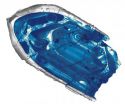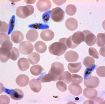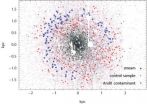(Press-News.org) SAN FRANCISCO, CA—February 23, 2014—The power of regenerative medicine now allows scientists to transform skin cells into cells that closely resemble heart cells, pancreas cells and even neurons. However, a method to generate cells that are fully mature—a crucial prerequisite for life-saving therapies—has proven far more difficult. But now, scientists at the Gladstone Institutes and the University of California, San Francisco (UCSF), have made an important breakthrough: they have discovered a way to transform skin cells into mature, fully functioning liver cells that flourish on their own, even after being transplanted into laboratory animals modified to mimic liver failure.
In previous studies on liver-cell reprogramming, scientists had difficulty getting stem cell-derived liver cells to survive once being transplanted into existing liver tissue. But the Gladstone-UCSF team figured out a way to solve this problem. Writing in the latest issue of the journal Nature, researchers in the laboratories of Gladstone Senior Investigator Sheng Ding, PhD, and UCSF Associate Professor Holger Willenbring, MD, PhD, reveal a new cellular reprogramming method that transforms human skin cells into liver cells that are virtually indistinguishable from the cells that make up native liver tissue.
These results offer new hope for the millions of people suffering from, or at risk of developing, liver failure—an increasingly common condition that results in progressive and irreversible loss of liver function. At present, the only option is a costly liver transplant. So, scientists have long looked to stem cell technology as a potential alternative. But thus far they have come up largely empty-handed.
"Earlier studies tried to reprogram skin cells back into a pluripotent, stem cell-like state in order to then grow liver cells," explained Dr. Ding, one of the paper's senior authors, who is also a professor of pharmaceutical chemistry at UCSF, with which Gladstone is affiliated. "However, generating these so-called induced pluripotent stem cells, or iPS cells, and then transforming them into liver cells wasn't always resulting in complete transformation. So we thought that, rather than taking these skin cells all the way back to a pluripotent, stem cell-like state, perhaps we could take them to an intermediate phase."
This research, which was performed jointly at the Roddenberry Center for Stem Cell Research at Gladstone and the Broad Center of Regeneration Medicine and Stem Cell Research at UCSF, involved using a 'cocktail' of reprogramming genes and chemical compounds to transform human skin cells into cells that resembled the endoderm. Endoderm cells are cells that eventually mature into many of the body's major organs—including the liver.
"Instead of taking the skin cells back to the beginning, we took them only part way, creating endoderm-like cells," added Gladstone and CIRM Postdoctoral Scholar Saiyong Zhu, PhD, one of the paper's lead authors. "This step allowed us to generate a large reservoir of cells that could more readily be coaxed into becoming liver cells."
Next, the researchers discovered a set of genes and compounds that can transform these cells into functioning liver cells. And after just a few weeks, the team began to notice a transformation.
"The cells began to take on the shape of liver cells, and even started to perform regular liver-cell functions," said UCSF Postdoctoral Scholar Milad Rezvani, MD, the paper's other lead author. "They weren't fully mature cells yet—but they were on their way."
Now that the team was encouraged by these initial results in a dish, they wanted to see what would happen in an actual liver. So, they transplanted these early-stage liver cells into the livers of mice. Over a period of nine months, the team monitored cell function and growth by measuring levels of liver-specific proteins and genes.
Two months post-transplantation, the team noticed a boost in human liver protein levels in the mice, an indication that the transplanted cells were becoming mature, functional liver cells. Nine months later, cell growth had shown no signs of slowing down. These results indicate that the researchers have found the factors required to successfully regenerate liver tissue.
"Many questions remain, but the fact that these cells can fully mature and grow for months post-transplantation is extremely promising," added Dr. Willenbring, associate director of the UCSF Liver Center and the paper's other senior author. "In the future, our technique could serve as an alternative for liver-failure patients who don't require full-organ replacement, or who don't have access to a transplant due to limited donor organ availability."
INFORMATION:
Other scientists who participated in this research include UCSF researchers Jack Harbell, MD, also a lead author on the paper, as well as Aras Mattis, MD, PhD, Alan Wolfe and Leslie Benet, PhD. Funding was provided by the following: the California Institute for Regenerative Medicine, the National Institutes of Health, the German Academic Exchange Service, and the Society of University Surgeons.
About the Gladstone Institutes
Gladstone is an independent and nonprofit biomedical-research organization dedicated to accelerating the pace of scientific discovery and innovation to prevent, treat and cure cardiovascular, viral and neurological diseases. Gladstone is affiliated with the University of California, San Francisco.
About UCSF
UCSF is a leading university dedicated to promoting health worldwide through advanced biomedical research, graduate-level education in the life sciences and health professions, and excellence in patient care. It includes top-ranked graduate schools of dentistry, medicine, nursing and pharmacy, a graduate division with nationally renowned programs in basic biomedical, translational and population sciences, as well as a preeminent biomedical research enterprise and two top-ranked hospitals, UCSF Medical Center and UCSF Benioff Children's Hospital.
Scientists transform skin cells into functioning liver cells
Joint Gladstone-UCSF study highlights novel reprogramming method; offers new hope for treating liver failure
2014-02-23
ELSE PRESS RELEASES FROM THIS DATE:
Oldest bit of crust firms up idea of a cool early Earth
2014-02-23
MADISON, Wis. – With the help of a tiny fragment of zircon extracted from a remote rock outcrop in Australia, the picture of how our planet became habitable to life about 4.4 billion years ago is coming into sharper focus.
Writing today (Feb. 23, 2014) in the journal Nature Geoscience, an international team of researchers led by University of Wisconsin-Madison geoscience Professor John Valley reveals data that confirm the Earth's crust first formed at least 4.4 billion years ago, just 160 million years after the formation of our solar system. The work shows, Valley says, ...
Researchers have identified a novel immunological mechanism of great importance for vaccine developm
2014-02-23
Researchers have discovered the presence of a novel subtype of innate lymphoid cells in human spleen essential for the production of antibodies. This discovery, published in the prestigious journal Nature Immunology, clears the path to the identification of novel strategies to develop more efficient vaccines against encapsulated bacteria, considered highly virulent.
This work was done by the B cell Biology research group at IMIM (Institut Hospital del Mar d'Investigacions Mediques) in Barcelona, directed by Dr. Andrea Cerutti, ICREA research professor and leader in the ...
A key protein is discovered as essential for malaria parasite transmission to mosquitos
2014-02-23
Two teams have independently discovered that a single regulatory protein acts as the master genetic switch that triggers the development of male and female sexual forms (termed gametocytes) of the malaria parasite, solving a long-standing mystery in parasite biology with important implications for human health. The protein, AP2-G, is necessary for activating a set of genes that initiate the development of gametocytes -- the only forms that are infectious to mosquitos. The research also gives important clues for identifying the underlying mechanisms that control this developmental ...
Stream of stars in Andromeda satellite galaxy shows cosmic collision
2014-02-23
The Andromeda Galaxy is surrounded by a swarm of small satellite galaxies. Researchers from the Niels Bohr Institute, among others, have detected a stream of stars in one of the Andromeda Galaxy's outer satellite galaxies, a dwarf galaxy called Andromeda II. The movement of the stars tells us that what we are observing is the remnant of a merger between two dwarf galaxies. Mergers between galaxies of such low mass has not been observed before. The results are published in the scientific journal, Nature.
The galaxies in the early universe started off small and the theory ...
Researchers pinpoint brain region essential for social memory
2014-02-23
NEW YORK, NY (February 23, 2014) — Columbia University Medical Center (CUMC) researchers have determined that a small region of the hippocampus known as CA2 is essential for social memory, the ability of an animal to recognize another of the same species. A better grasp of the function of CA2 could prove useful in understanding and treating disorders characterized by altered social behaviors, such as autism, schizophrenia, and bipolar disorder. The findings, made in mice, were published today in the online edition of Nature.
Scientists have long understood that the hippocampus—a ...
Nanoparticles target anti-inflammatory drugs where needed
2014-02-23
Researchers at the University of Illinois at Chicago have developed a system for precisely delivering anti-inflammatory drugs to immune cells gone out of control, while sparing their well-behaved counterparts. Their findings were published online Feb. 23 in Nature Nanotechnology.
The system uses nanoparticles made of tiny bits of protein designed to bind to unique receptors found only on neutrophils, a type of immune cell engaged in detrimental acute and chronic inflammatory responses.
In a normal immune response, neutrophils circulating in the blood respond to signals ...
Climate change won't reduce deaths in winter
2014-02-23
New research published today (Sunday 23rd February) has found that climate change is unlikely to reduce the UK's excess winter death rate as previously thought.
The study is published in the journal Nature Climate Change and debunks the widely held view that warmer winters will cut the number of deaths normally seen at the coldest time of year.
Analysing data from the past 60 years, researchers at the University of Exeter and University College London (UCL) looked at how the winter death rate has changed over time, and what factors influenced it.
They found that from ...
Scientists unlock a 'microbial Pompeii'
2014-02-23
An international team of researchers have discovered a 'microbial Pompeii' preserved on the teeth of skeletons around 1,000 years old. The key to the discovery is the dental calculus (plaque) which preserves bacteria and microscopic particles of food on the surfaces of teeth, effectively creating a mineral tomb for microbiomes.
The research team discovered that the ancient human oral cavity carries numerous opportunistic pathogens and that periodontal disease is caused by the same bacteria today as in the past, despite major changes in human diet and hygiene.
The researchers ...
Christian Band The Sunrise to Perform at the 2014 Bringing America Back to Life Symposium
2014-02-23
The Sunrise will be performing at this year's Bringing America Back to Life Symposium and Exhibition presented by Cleveland Right to Life on March 7th, 2014 & March 8th, 2014.
The event features pro-life speakers including David Barton of WallBuilders, and Pam Tebow, mother of Tim Tebow. This is one of the nation's largest pro-life events of its kind, and the event completely sold out in 2013.
Those interested in attending this event can visit the Bringing America Back to Life website at: http://www.bringingamericabacktolife.org/index.html
In addition, The ...
Victory Over Stroke Symposium Set for March 20, 2014
2014-02-23
The Stroke Association of Florida has announced its Fifth Annual Victory Over Stroke symposium, scheduled for Thursday, March 20, 2014, 9 a.m. to 1 p.m., at H2U Blake Medical Center, 6670 Cortez Road W. in Bradenton, Florida.
Ana M. Guillermo, H2U Program Manager, will emcee the free event, which includes presentations from distinguished local speakers, free stroke risk health screenings and exhibitors. Lunch will be provided.
"The goal of Victory Over Stroke is to raise awareness about stroke symptoms and the critical need to call 911, what you can do to minimize ...
LAST 30 PRESS RELEASES:
New software sheds light on cancer’s hidden genetic networks
UT Health San Antonio awarded $3 million in CPRIT grants to bolster cancer research and prevention efforts in South Texas
Third symposium spotlights global challenge of new contaminants in China’s fight against pollution
From straw to soil harmony: International team reveals how biochar supercharges carbon-smart farming
Myeloma: How AI is redrawing the map of cancer care
Manhattan E. Charurat, Ph.D., MHS invested as the Homer and Martha Gudelsky Distinguished Professor in Medicine at the University of Maryland School of Medicine
Insilico Medicine’s Pharma.AI Q4 Winter Launch Recap: Revolutionizing drug discovery with cutting-edge AI innovations, accelerating the path to pharmaceutical superintelligence
Nanoplastics have diet-dependent impacts on digestive system health
Brain neuron death occurs throughout life and increases with age, a natural human protein drug may halt neuron death in Alzheimer’s disease
SPIE and CLP announce the recipients of the 2025 Advanced Photonics Young Innovator Award
Lessons from the Caldor Fire’s Christmas Valley ‘Miracle’
Ant societies rose by trading individual protection for collective power
Research reveals how ancient viral DNA shapes early embryonic development
A molecular gatekeeper that controls protein synthesis
New ‘cloaking device’ concept to shield sensitive tech from magnetic fields
Researchers show impact of mountain building and climate change on alpine biodiversity
Study models the transition from Neanderthals to modern humans in Europe
University of Phoenix College of Doctoral Studies releases white paper on AI-driven skilling to reduce burnout and restore worker autonomy
AIs fail at the game of visual “telephone”
The levers for a sustainable food system
Potential changes in US homelessness by ending federal support for housing first programs
Vulnerability of large language models to prompt injection when providing medical advice
Researchers develop new system for high-energy-density, long-life, multi-electron transfer bromine-based flow batteries
Ending federal support for housing first programs could increase U.S. homelessness by 5% in one year, new JAMA study finds
New research uncovers molecular ‘safety switch’ shielding cancers from immune attack
Bacteria resisting viral infection can still sink carbon to ocean floor
Younger biological age may increase depression risk in older women during COVID-19
Bharat Innovates 2026 National Basecamp Showcases India’s Most Promising Deep-Tech Ventures
Here’s what determines whether your income level rises or falls
SCIE indexation achievement: Celebrate with Space: Science & Technology
[Press-News.org] Scientists transform skin cells into functioning liver cellsJoint Gladstone-UCSF study highlights novel reprogramming method; offers new hope for treating liver failure


